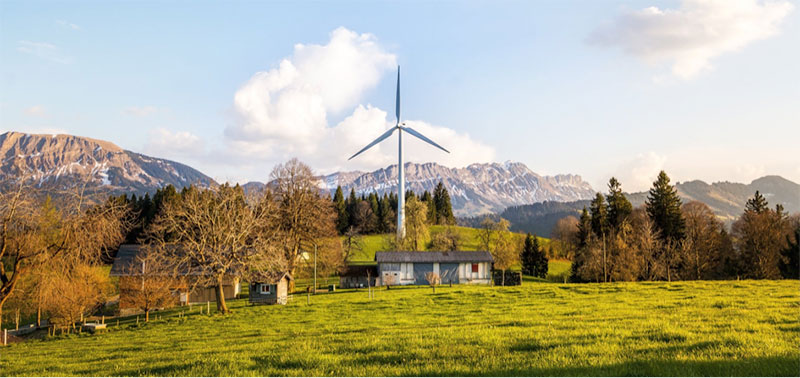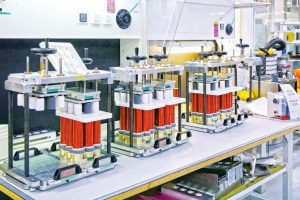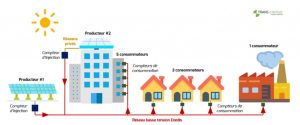It is at the local level that many of the challenges and solutions of the energy transition are to be found. Indeed, the potential of renewable energy sources is decentralized and cannot be exploited without strong local dynamism from citizens, municipalities, and traditional players in the energy world. As a result, local energy communities are forming all over the world. What are the motivating factors behind this new trend? What technologies and regulations allow these emerging needs to be met?
The notions of energy communities are very disparate. There are communities that originate from local initiatives and physically occupy a small piece of territory, neighbourhood, village, or campus. This is the type of community referred to below. But there are also other communities of the virtual type, with geographically dispersed energy resources, which are not referred to below.
1. Definition and motivations
What does a local energy community consist of? What are the innovations of its initiators?
1.What is a local energy community?
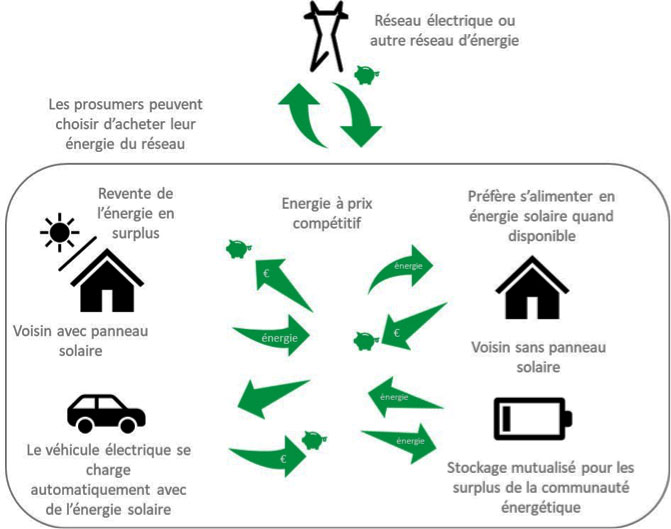
The European Commission’s definition, which is still subject to discussion, is as follows. A LEC is defined as an association, a cooperative, a partnership, a non-profit organisation or other legal entity which is effectively controlled by local shareholders or members, generally value- rather than profit-driven, involved in distributed generation and in performing activities of a distribution system operator, supplier or aggregator at local level[1].
1.2. Economic interest
Solar PV will soon be the cheapest source of electricity: the average cost of solar PV has fallen by 73% since 2010. Public-scale solar installations now cost less than $1 per watt, and the LCOE[2] (the Levelized Cost of Energy
for solar PV) is expected to be cut in half again by 2020, with the best projects likely to provide electricity for around $3 c/kWh or less within two years.
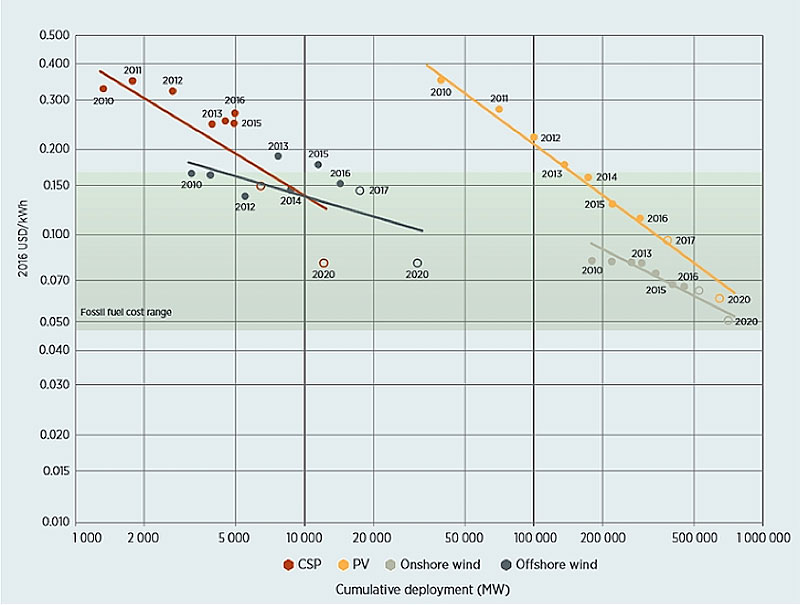
The reduction in PV hardware costs was achieved by a simple scaling factor of the PV generation infrastructure. The following Figure 2 from the IRENA Renewable Energy Costs 2017 study shows these developments[3].
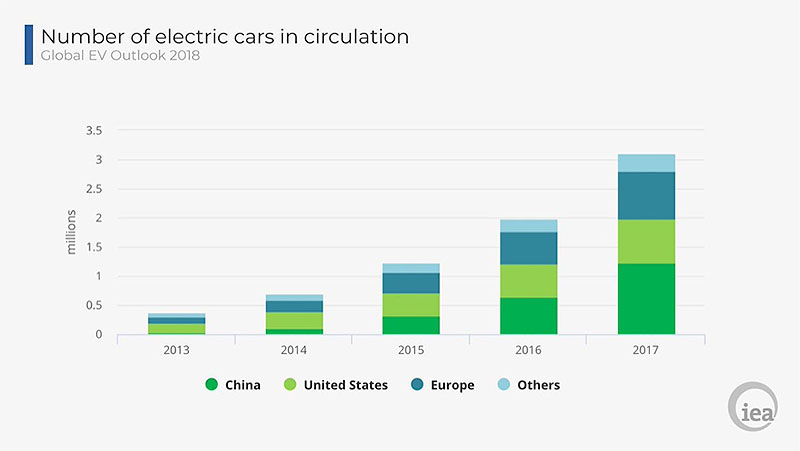
Of course, storage has to be taken into account if we want to compare different sources of energues. But the same revolution is taking place in energy storage. The costs of these devices have fallen from over USD 500/kWh in 2013 to around USD 200/kWh today and are expected to reach less than USD 100/kWh in the next five to ten years [4]. This decrease is strongly boosted by the development of electric vehicles (Figure 3).
Thus, the cost of decentralized energy tends to decrease, and this economic gain is one of the motivations of the members of the energy community. Furthermore, the stability of a new village power plant or wind turbine project and its tangible character is also an important dimension. The investment is visible, unlike virtual investments. The investment in a shared storage battery or a wind turbine is quite visible to the members of a community. They can see it and know that they own part of it.
1.3. Ecology and commitment
Certain values shared by community members such as environmental protection, support for the development of renewable energy technologies and the protection of future generations are crucial to this movement. However, the predominance of these objectives is reduced, if the costs increase or the act becomes too complicated or time consuming[5]. On the other hand, collective action is not necessary if one person can achieve this goal also alone. Energy communities are formed when an individual action involves more sacrifice and effort than doing it with others or does not achieve the desired standard. Thus, if one person decides to invest in renewable energy with others, then he or she can claim access to more efficient and more expensive technology for less money and time, as the joint investment reduces costs and risks[6].
Other ideological reasons such as improving the living conditions of the neighbourhood, serving as an example to others and supporting and strengthening the local community are among the motivations. In addition, some people may join community energy projects because of direct or indirect social pressures if they do not want to be left out[7].
1.4. Security of energy supply
In some industrialized countries, the aging electricity grid lacks resilience to outages or instabilities, especially when subjected to severe weather events.
The number of power outages lasting more than one hour has steadily increased over the past decades. The main reason for the increase in blackouts associated with weather hazards is the aging of the infrastructure. The need for resilience may therefore be an expectation of the energy communities (Read: Microgrids: How do they contribute to the energy transition?).
Another motivation is to protect community members from future higher energy costs and also in some cases to be more autonomous from utility companies[8].
1.5. Hedonism
Hedonism is a complement to the previous motivations. It is, for example, the satisfaction of being able to control one’s own energy resources with advanced technology or to collaborate with others on a common project, to improve one’s self-image by participating in a project that is environmentally friendly.
2. Regional particularities
The current situation shows a scattered development, where local energy communities are formed on a case-by-case basis, with different technical and organizational characteristics.
2.1. Europe
The European Commission’s “Winter Package” (COM 2016 864 final/2), consists of a set of legislative measures to facilitate the transition to clean energy. Reference is made to Local Energy Communities (LECs) to ensure greater consumer participation in the energy market through greater local ownership of decentralised renewable generation.
According to a study by CE Delft[9], by 2050 almost half of all households in the European Union (EU) could be involved in renewable energy production, of which about 37% could come from energy communities. Furthermore, according to the European Commission, by 2030, more than 50 GW of wind energy and more than 50 GW of solar energy could be owned by energy communities, representing 17% and 21% of the installed capacity respectively.
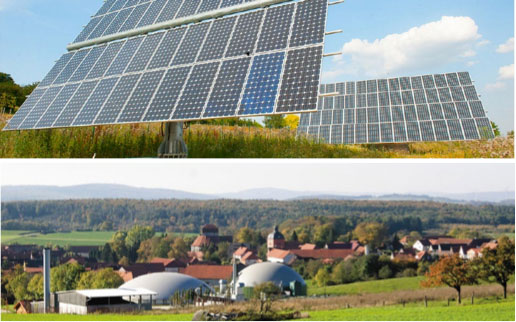
The involvement of citizens in the production of renewable energy can, in addition to the dynamism thus created locally, increase social acceptance, and thus accelerate the energy transition. This is what the European Commission wants to achieve through the ” Winter Package“.
The energy community project of the village of Jühnde, an agricultural village in Lower Saxony, Germany, with 780 inhabitants, is presented below. The farming village produces 100% heat and electricity from renewable energy sources and thus covers all its needs. The core of the energy production comes from a methane-fuelled biogas plant, which is supplemented in winter by wood chips. The heat is distributed to households via a local network. The total heat production of the village is 6,500 MWh/year, while 5,000 MWh of electricity is produced annually. The project was financed by government and regional funds and the rest by residents and some investors. It took five years to set up the project. The motivation of the participants was maintained by a constant information policy and the involvement of the villagers in working groups. Today, 70% of residents are members of the cooperative. Currently, 12 other villages in the region want to become the next bioenergy village[10].
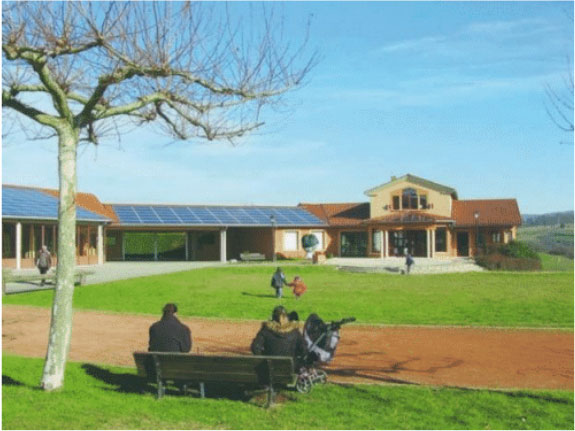
In France, we are witnessing the emergence of “Centrales Villageoises”, which are local companies whose goal is to develop renewable energies in a given territory by bringing together citizens, communities, and local businesses. Thus, Auvergne-Rhône-Alpes Énergie Environnement has founded the implementation of a replicable model[11]. For example, Les Haies, a village of 810 inhabitants in the Condrieu region (Rhône) was chosen as a pilot site. 500m2 of photovoltaic panels were installed on eight public and private roofs in the commune, for a total power of 76 kWp injected into the low-voltage electricity grid. The investment and operation of the project is being handled by SAS Centrales Villageoises de la Région de Condrieu, a cooperative company with 160 shareholders, most of whom are local citizens and residents.
In France, other pilot projects on a neighbourhood scale have been developed. For example, the IssyGrid project is an experimental project designed to test the optimization of consumption and production of renewable energy in two districts (Seine Ouest and Fort d’Issy) of the city of Issy-les-Moulineaux through a smart electricity distribution network. This experiment, which was announced, was launched in April 20123 and has been fully operational since September 2013. The experiment involves 2,000 homes, 5,000 inhabitants, 160,000 m2 of offices and 10,000 employees on a daily basis.
2.2. Japan
The concept of local energy community is expanded. Japan has set up the development of Smart Communities and includes the efficient use of energy following the example of the European Local Energy Communities, but also local transport systems and the transformation of the daily life of citizens. The notion of resilience mentioned in the benefit chapter above is important and follows the Fukushima disaster of March 2011. The Japan Smart Community Alliance has been formed. It is an organization composed of national companies that was created to accumulate knowledge and promote collaboration between the public and private sectors. The JSCA addresses various issues such as standardization and emergence and contributes to the preparation of Japan’s roadmaps.
Four major projects to test the next generation energy and social system were launched in April 2010, under the leadership of Japan’s Ministry of Economy, Trade and Industry. These four projects are partly funded by the Japanese Ministry of Economy, Trade and Industry (METI) and involve, in addition to the Japanese municipalities where the projects are taking place, multiple Japanese industrialists: TEPCO, Toshiba, Nissan, Panasonic, Hitachi, Mitsubishi, etc. Generally speaking, these four projects involve energy management at the community level (CEMS) and at the residential and tertiary levels (HEMS, BEMS) with incentives to reduce consumption during peak periods (active demand management, or demand/response, D/R). Two of them are described below:
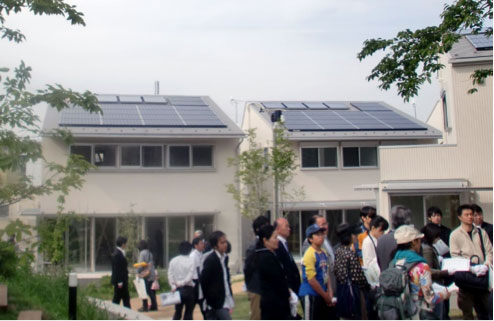
YSCP (Yokohama Smart City Project) involves a city of 3.7 million people. Solar panels have been installed on 249 sites, for a total production of 37MW. At the same time, a dozen sites have been equipped with wind power, hydroelectricity, or biomass. Energy resources and flexibilities are located at the individual level at home, at the level of buildings as well as industrial installations. A global control and supervision system allow to measure the performance of the system.
The Keihanna Eco City project covers three municipalities in the south of Kyoto Prefecture: Kyotanabe, Kizugawa and Seika. These three municipalities represent 173,301 inhabitants. It is a large area including universities, research laboratories, factories, but also residents and businesses. The project (funded by METI) is implemented in three areas, namely Kyotanabe City, Kizugawa City and Seika City in Kyoto. The main objective of the Keihanna pilot project is to optimize energy use throughout the area and reduceCO2 emissions. Both residential and commercial buildings are involved. The system includes residential solar panels and an associated residential control system (HEMS: Home Management System), tertiary buildings controlled by a BEMS ( Building Energy Management system), an electric vehicle integration system, all of which are controlled by a CEMS (Community Energy Management system) which acts as an intermediary between the energy community and the electricity company. It is as if the CEMS were a supplier for the users, although it does not produce electricity directly. The CEMS guarantees a fixed amount of electricity to the utility[12] and reliable, green energy to the community by managing the photovoltaic production, storage batteries and consumption reductions.
According to[13] these projects have been made possible by strong government involvement while giving local authorities room to manoeuvre. At the local level, the energy sector has been disrupted, marked by the arrival of new entrants (ICT and mobility firms) and a multi-sectoral approach by most of the companies involved, investing in energy production, storage and management, mobility systems or data management.
2.3. the United States
According to NREL, the federal energy efficiency and renewable energy laboratory, a Renewable Energy Community is a local system in which renewable energy meets the energy supply and demand needs of its residents, with the ability to provide surplus energy to the grid or to other communities. At a minimum, this community will have near-zero or zero energy homes, integrated transportation systems. The community will provide economic benefits and a positive impact on the quality of life for its members. For example, the community will have to be powered by energy sources and will integrate power systems for homes and vehicles.

The example of the Brooklyn Energy Community is the most famous, as it reinvents the traditional energy network model, with the concept of a common energy network. While the power provider still maintains the electrical grid that guarantees the stability of the electricity, the actual energy is generated, stored, and traded locally by the community members, for a more resilient and sustainable clean energy model. The system consists of prosumers with solar panels. Blockchain technology is used to manage virtual currency transfers between participants (Read: Blockchains for energy).
3. Architecture and technology
The architecture and technologies of local energy communities are based on smart grid and microgrid technology. A typical example is shown in Figure 8.
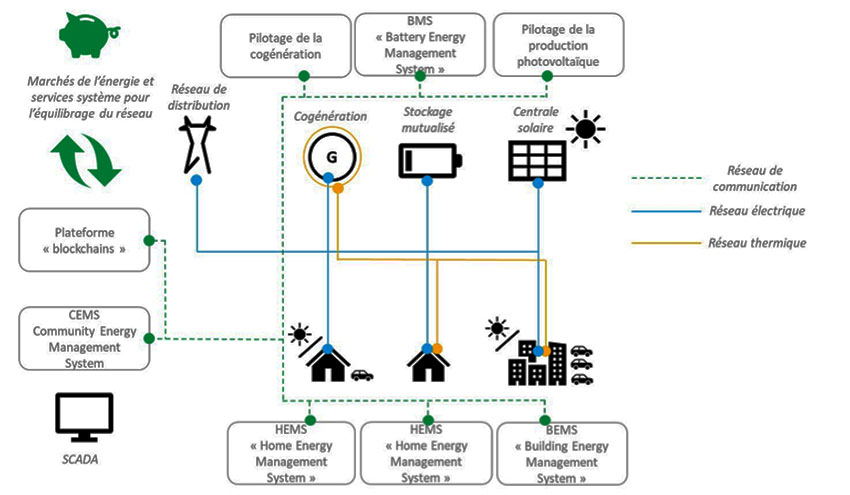
The system may include:
- Energy networks (electricity, heat, gas)
- Communication networks: dedicated cables – ethernet – or power line carriers – PLC, optical fibres, atmosphere, or vacuum (4G, radio waves etc.)
- HEMS(Home Energy Management System) for residential use. These systems allow the optimization of energy use and decentralized production and the electric vehicle in the home, but also participate in energy exchanges with the upstream system (of the Demand / Response (D/R) type), in this case the Energy Community
- Energy management systems at the level of a building or a campus (BEMS: Building Energy Management System). They allow to optimize energy consumption, storage, decentralized production, a fleet of electric vehicles and also to participate in energy exchanges with the upstream energy network.
- Shared production and/or storage facilities, e.g. cogeneration to produce electricity and heat from biomass gas, solar and/or wind power plants, storage, etc.
- A global management system CEMS(Community Management System) which allows to optimize energy flows within the community with possibly islanding capabilities
- A system for managing financial flows that can be based on blockchain technology (Read Blockchains at the service of energy).
4. Stakeholders
Energy cooperatives are one of the most common forms of local energy community. Unlike traditional businesses, cooperatives are owned by the members of the community on a “one member – one vote” basis and aim to maximize local benefits rather than capital returns[14].
In addition to the Local Energy Community itself, new actors are emerging around these emerging communities. These include energy service providers, municipal utilities, housing associations, transportation solution providers, energy cooperatives, aggregators etc. These new players are collaborating with traditional smart grid players such as Distribution System Operators (DSOs) to implement these solutions.
In Europe[15], refers to the following players:
1. Municipalities. Municipalities have generally gained the trust of communities and are motivated to achieve energy efficiency and integrate more renewables in their territories. Moreover, they play a key role in the replication of these projects. In the CITyFiED project, for example, three municipalities are collaborating to create a replicable strategy to adapt European cities and urban ecosystems to the smart city of the future.[16] Similarly, in the SINFONIA project, two municipalities in Italy and Austria are working together to achieve primary energy savings and increase the share of renewable energy in two pioneer districts.
2. DSOs or Distribution System Operators. By its nature, a local energy community will have a portion of the distribution network and therefore will have to collaborate in some way with a DSO. DSOs, as neutral market facilitators, play a leading role in the development and operation of the local energy community[18] by providing various network infrastructure services. But they can also benefit from the various services provided by the local energy community, e.g. the flexibility to optimise or even defer certain investments in the distribution network. However, the collaboration of private and public parties still needs to be clarified[19].
3. The3rd category consists of new emerging players such as :
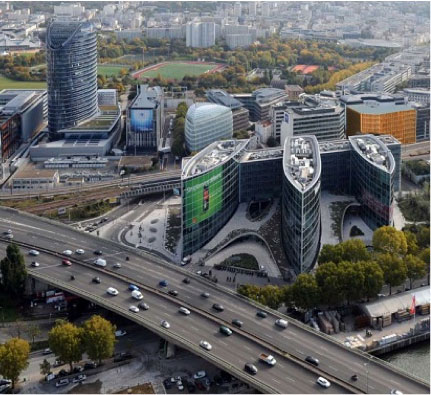
- Property developers and housing associations, where one of the main objectives of the projects in which these actors participate is to improve energy efficiency in social housing. For example, in the 3E-Houses project, a Spanish property developer, a Bulgarian housing association, a UK municipality and a German energy service provider are collaborating with other actors to increase the energy efficiency of publicly subsidised homes[20].
- 20] Energy solution and service providers whose role is to facilitate customer participation in achieving the goals of a Local Energy Community, including reducing energy consumption, participating in the energy market, and optimizing energy production. In the case of Issygrid, an energy service company collaborates with a group of businesses located in the community, but also with technology solution providers and the grid operator creating a large-scale smart grid in a district that manages the production, consumption and storage of renewable energy.
5. Regulation
In Europe, several key processes contribute to the emergence of these energy communities[21] :
- Municipalization of energy – the process of increasing municipal control over local energy management.
- Deconcentrating – the process of increasing the strategic and political role of local authorities in energy policy.
- Participatory governance – the promotion of direct democracy and citizen influence on energy and climate policy.
Thus, in France for example, the Law on the Energy Transition for Green Growth (TECV), enacted on August 18, 2015 promotes and forces the emergence of energy territorialisation.
The creation and maintenance of a stable political environment for the promotion of renewable energy in particular financial support independent of energy market prices is one of the key factors for success. However, the following other key success factors must also be met[22] :
- A clear and simple legal framework governing the creation and operation of an energy system and its access to the energy market,
- Access to financing instruments or partnerships to reduce investment risks,
- Synergies and partnerships with local and regional authorities.
Thus, there is heterogeneity in Europe, with the European leaders of this new trend being Germany and Denmark.
The success of local energy communities in Germany can be attributed to a number of factors, including a well-established ecological movement for alternative energy and environmental protection, as well as a tradition of forming co-operatives and other associations to achieve change at the local level; a high level of power and support from municipalities; and institutional factors such as the feed-in tariff system or the support of the state-owned development bank, KfW[23].
In Greece, a new law on energy communities was in January 2018 that encourages citizens, authorities, and private and public bodies to participate in the production, distribution, and supply of energy. The law now allows energy communities to produce, sell or self-consume electricity and thermal energy produced by cogeneration [24].
In France, collective self-consumption has been possible since 2017 and made possible by the Distribution System Operator (DSO). Consumers and the production unit in a housing estate, for example, are linked together within a legal entity that signs an agreement with the DSO. The DSO thus facilitates the local production of energy, provides reliable and certified measurement data for the calculation of the community members’ share of energy produced, ensures the continuity and quality of the supply to the distribution network with or without a local production source and allows the community members a free choice of their electricity supplier. Surplus energy can be resold on the energy market[25].
6. Conclusion
Local energy communities are emerging in Europe and almost everywhere in the world with a specific technical and organizational development. The motivations are numerous but are essentially economic and environmental. This trend will help to drive the energy transition by facilitating local and regional cooperation and involving citizens in the energy transition. Smart grid and microgrid technologies are now operational and the cost of local renewable energies associated with storage is falling, making the price of the kWh produced accessible and even competitive in some countries. Regulation is evolving and, although very heterogeneous, is gradually tending to facilitate this new trend.
Notes and references
[1] Georgia ASIMAKOPOULOU & Nikos HATZIARGYRIOU from National Technical University of Athens, School of Electrical and Computer Engineering School: MODELS FOR THE INTEGRATION OF LOCAL ENERGY COMMUNITIES IN ENERGY MARKETS. Ljubljana Slovenia June 2018. CIRED
[2]LCOE is the acronym for “Levelized Cost of Energy”. It corresponds to the full price of energy over the lifetime of the equipment that produces it. For this calculation, which includes both an initial investment (CAPEX) and operating costs spread over a long period (OPEX), the discounting technique is necessary. The LCOE is an economic estimate of the cost of the system defined by : [discounted investment + operational and maintenance costs] divided by [the electricity output (number of kWh) it will produce over its lifetime].
[3]IRENA Renewable Power Generation Costs in 2017. ISBN 978-92-9260-040-2. January 2018
[4]Rodolphe HELIOT: Energy Communities are reshaping The Energy value chain. Aster Capital May 2017
[5]Gabriella Dóci, Eleftheria Vasileiadou: “Let’s do it ourselves” Individual motivations for investing in renewables at community level, Renewable and Sustainable Energy Reviews, May 2015
[6]Gabriella Dóci, Eleftheria Vasileiadou: “Let’s do it ourselves” Individual motivations for investing in renewables at community level, Renewable and Sustainable Energy Reviews, May 2015
[7]Gabriella Dóci, Eleftheria Vasileiadou: “Let’s do it ourselves” Individual motivations for investing in renewables at community level, Renewable and Sustainable Energy Reviews, May 2015
[8]Gabriella Dóci, Eleftheria Vasileiadou: “Let’s do it ourselves” Individual motivations for investing in renewables at community level, Renewable and Sustainable Energy Reviews, May 2015
[9]Bettina Kampman, Jaco Blommerde, Maarten Afman Delft, CE Delft, The potential of energy
citizens in the European Union Publication code: 16.3J00.75 September 2016
[10]Gabriella Dóci, Eleftheria Vasileiadou: “Let’s do it ourselves” Individual motivations for investing in renewables at community level, Renewable and Sustainable Energy Reviews, May 2015
[11] http://www.centralesvillageoises.fr
[12]Bruno Faivre d’Arcier, Yveline Lecler, Benoît Granier, Nicolas Leprêtre KEIHANNA : Keihanna Eco-City Next-Generation Energy and Social System. HAL Id: halshs-01382709 Oct 2016
[13]Interview with Nicolas Leprêtre (East Asia Institute) Smart Grid CRE September 2015
[14] ] https://www.enedis.fr/autoconsommation-collective
[15]Antonios MARINOPOULOS, Julija VASILJEVSKA, Anna MENGOLINI, European Commission, Joint Research Center ” LOCAL ENERGY COMMUNITIES: AN INSIGHT FROM EUROPEAN SMART GRID PROJECTS ” CIRED Workshop – Ljubljana, 7-8 June 2018
[16]Antonios MARINOPOULOS, Julija VASILJEVSKA, Anna MENGOLINI, European Commission, Joint Research Center ” LOCAL ENERGY COMMUNITIES: AN INSIGHT FROM EUROPEAN SMART GRID PROJECTS ” CIRED Workshop – Ljubljana, 7-8 June 2018
[17]Antonios MARINOPOULOS, Julija VASILJEVSKA, Anna MENGOLINI, European Commission, Joint Research Center ” LOCAL ENERGY COMMUNITIES: AN INSIGHT FROM EUROPEAN SMART GRID PROJECTS ” CIRED Workshop – Ljubljana, 7-8 June 2018
[18]Antonios MARINOPOULOS, Julija VASILJEVSKA, Anna MENGOLINI, European Commission, Joint Research Center ” LOCAL ENERGY COMMUNITIES: AN INSIGHT FROM EUROPEAN SMART GRID PROJECTS ” CIRED Workshop – Ljubljana, 7-8 June 2018
[19]Ruth VAN CAENEGEM, Eandis – Belgium, Wim CARDINAELS EnergyVille – Belgium, Frederik LOECKX, Flux50 – Belgium, Freddy VAN BOGGET KBC-Belgium, ORGANISATION OF THE COMMERCIAL AND PUBLIC SERVICES FOR THE INSTALLATION OF LOCAL AND RENEWABLE ENERGY COMMUNITIES (LEC/REC), CIRED Workshop – Ljubljana, 7-8 June 2018
[20]Antonios MARINOPOULOS, Julija VASILJEVSKA, Anna MENGOLINI, European Commission, Joint Research Center ” LOCAL ENERGY COMMUNITIES: AN INSIGHT FROM EUROPEAN SMART GRID PROJECTS ” CIRED Workshop – Ljubljana, 7-8 June 2018
[21]European Union, 2018, Models of Local Energy Ownership and the Role of Local Energy Communities in Energy Transition in Europe, ISBN: 978-92-895-0989-3, doi:10.2863/603673, QG-01-18-933-EN-N 2018
[22]European Union, 2018, Models of Local Energy Ownership and the Role of Local Energy Communities in Energy Transition in Europe, ISBN: 978-92-895-0989-3, doi:10.2863/603673, QG-01-18-933-EN-N 2018
[23]European Union, 2018, Models of Local Energy Ownership and the Role of Local Energy Communities in Energy Transition in Europe, ISBN: 978-92-895-0989-3, doi:10.2863/603673, QG-01-18-933-EN-N 2018
[24]European Union, 2018, Models of Local Energy Ownership and the Role of Local Energy Communities in Energy Transition in Europe, ISBN: 978-92-895-0989-3, doi:10.2863/603673, QG-01-18-933-EN-N 2018
[25] https://www.enedis.fr/autoconsommation-collective
The Encyclopedia of Energy is published by the Association des Encyclopédies de l’Environnement et de l’Énergie(www.a3e.fr), contractually linked to Grenoble Alpes University and Grenoble INP, and sponsored by the Academy of Sciences.
To cite this article, please mention the author’s name, the title of the article and its URL on the Encyclopedia of Energy website.
The articles of the Encyclopedia of Energy are made available under the terms of the license Creative Commons Attribution – Noncommercial – No Derivative Works 4.0 International.


